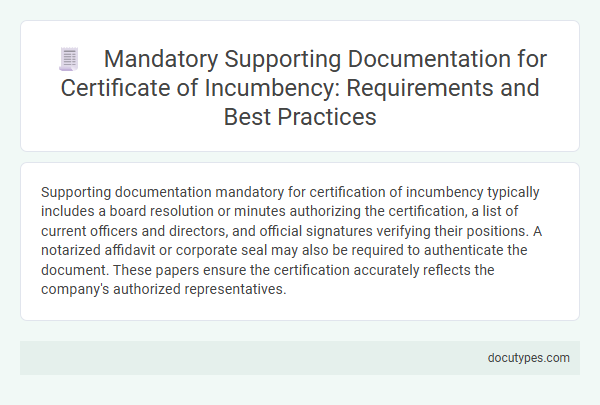Supporting documentation mandatory for certification of incumbency typically includes a board resolution or minutes authorizing the certification, a list of current officers and directors, and official signatures verifying their positions. A notarized affidavit or corporate seal may also be required to authenticate the document. These papers ensure the certification accurately reflects the company's authorized representatives.
Introduction to Certificate of Incumbency
A Certificate of Incumbency is an official document that verifies the identities of current company officers or directors. It serves as proof of authority for individuals to act on behalf of the company in legal and financial matters.
- Company Resolution - A formal company resolution authorizing the issuance of the Certificate of Incumbency is required to confirm board approval.
- Corporate Charter Documents - Certified copies of the company's articles of incorporation or bylaws must accompany the certificate to verify legal standing.
- Identification of Officers - Valid identification documents for the named officers or directors are mandatory to authenticate their incumbency.
Definition and Purpose of Supporting Documentation
| Aspect | Description |
|---|---|
| Definition of Supporting Documentation | Supporting documentation refers to official papers and records that validate the authenticity and accuracy of the Certificate of Incumbency. These documents typically include corporate resolutions, board meeting minutes, shareholder registers, and identification proof of authorized signatories. |
| Purpose of Supporting Documentation | Supporting documentation ensures the certificate's legitimacy by providing evidence of the current office holders and authorized representatives within an organization. It safeguards against fraudulent claims and confirms the authority of individuals named in the certificate for legal and financial transactions. |
| Mandatory Supporting Documents | Mandatory items commonly required are copy of corporate charter or articles of incorporation, recent board resolutions confirming incumbents, shareholder registry excerpts, government-issued identification of officers, and official company seals or stamps. |
| Role in Certification Process | These documents form the foundation for verifying company structure and authorized personnel during the certification process. Providing complete and accurate supporting documents expedites review, reduces the risk of rejection, and enhances trust in the certificate's validity. |
Key Mandatory Documents for Certificate of Incumbency
Key mandatory documents for a Certificate of Incumbency include a board resolution authorizing the issuance of the certificate and a company register listing current directors and officers. These documents verify the legitimacy of the individuals holding corporate positions.
Certified copies of identification for the directors and officers are often required to confirm their identities. Additionally, an official letterhead and company seal enhance the document's authenticity and acceptance.
Legal Framework and Regulatory Requirements
Supporting documentation for certification of incumbency must comply with the legal framework established by corporate and commercial law. These documents typically include corporate resolutions, board meeting minutes, and official identification of authorized representatives to verify incumbency.
Regulatory requirements mandate that supporting documents be authentic, dated, and properly executed to ensure legal validity. Compliance with jurisdiction-specific regulations is essential to avoid disputes and confirm the authority of individuals or entities certified as incumbents.
Identity Verification: Accepted Documents
Verification of identity is a critical component in the certification of incumbency process. Acceptable documents must unequivocally establish the identity of the individual involved.
- Government-issued photo ID - This includes passports, national identity cards, or driver's licenses that provide a clear photo and personal details.
- Utility bills or bank statements - Recent documents showing the individual's name and residential address, not older than three months.
- Corporate records or resolutions - Official documents from the company confirming the incumbency and authorized signatory status of the individual.
Submitting these accepted identity verification documents ensures compliance with certification requirements and helps prevent fraud.
Evidence of Corporate Existence and Good Standing
Certification of Incumbency requires supporting documentation that verifies the corporation's legal status and confirms its authorized representatives. Evidence of Corporate Existence and Good Standing is a mandatory aspect of this verification process.
Acceptable documentation includes a Certificate of Good Standing or a Certificate of Existence issued by the relevant state or country authority. This document affirms that the corporation is duly registered, compliant with regulations, and authorized to conduct business. It serves as proof that the entity is active and in good standing with governmental agencies, ensuring the legitimacy of the certification.
Authorized Signatories: Proof and Documentation
Supporting documentation is essential to verify the authorized signatories listed in a Certificate of Incumbency. These documents provide legal proof of an individual's authority to act on behalf of the company.
- Company Resolution - A formal company resolution must be submitted to confirm the appointment of authorized signatories.
- Identification Documents - Valid government-issued IDs are required to verify the identity of each authorized signatory.
- Official Signature Specimen - A specimen of the authorized signatory's signature must be provided to ensure authenticity and prevent fraud.
Common Mistakes in Submitting Supporting Documents
Supporting documentation for certification of incumbency must include a certified copy of the board resolution and a valid government-issued ID of the authorized signatories. Common mistakes include submitting outdated documents, incomplete resolutions, or illegible identification, which can delay the certification process. Ensuring all documents are current, clearly scanned, and accurately reflect authorized personnel is crucial for smooth processing.
Best Practices for Document Preparation and Submission
What supporting documentation is mandatory for certification of incumbency? Essential documents typically include a board resolution, a list of officers, and identification proofs. Following best practices ensures accuracy and completeness when preparing and submitting these materials.
What Supporting Documentation Is Mandatory for Certification of Incumbency? Infographic

